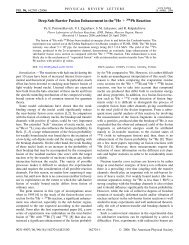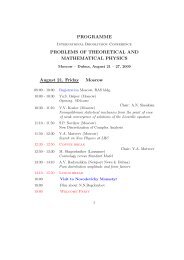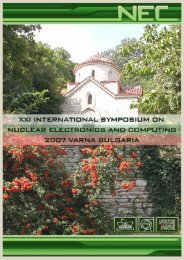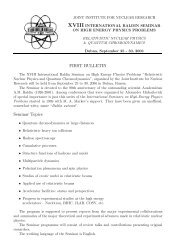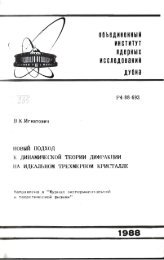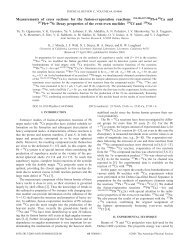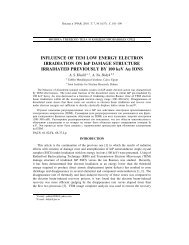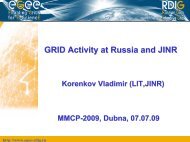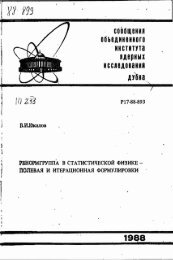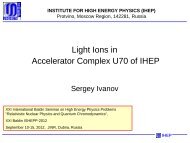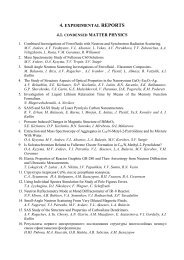di-neutron - Nrv Jinr
di-neutron - Nrv Jinr
di-neutron - Nrv Jinr
You also want an ePaper? Increase the reach of your titles
YUMPU automatically turns print PDFs into web optimized ePapers that Google loves.
( )<br />
G.M. Ter-Akopian et al.rPhysics Letters B 426 1998 251–256 253<br />
Fig. 1. Scheme of the experimental set up. DE0<br />
stands for the<br />
plastic scintillation detector used for the beam monitoring, DE 21<br />
Ž<br />
2<br />
is an array of position sensitive detectors eight 64P8 mm , 0.3<br />
mm thick Si strips .. Dimensions of other telescope detectors Žthe<br />
two numbers that follow in parentheses the notation of each<br />
detector are, respectively, the detector <strong>di</strong>ameter and thickness,<br />
both in mm .: DE Ž 16, 0.03 ., DE Ž 20, 0.10 ., DE Ž 48, 0.54 .<br />
11 12 13 ,<br />
DE Ž 50, 3.0 ., DE Ž 55, 0.52 ., DE Ž 68, 0.68 ., DE Ž 66, 7.7 ..<br />
14 22 33 24<br />
array of position sensitive Si strips Ždetector DE21<br />
in<br />
Fig. 1.<br />
for measuring the scattering angle. The second<br />
telescope also served for detecting the 6 He<br />
nuclei scattered in the forward <strong>di</strong>rection from the<br />
helium target. The energy resolution of each detector<br />
used in the telescopes was better than 100 keV for<br />
the 5.5 MeV alpha line of 238 Pu. The solid angle of<br />
each of the two telescopes was ;75 msr in the<br />
laboratory system. Both telescopes were placed in a<br />
horizontal plane.<br />
The backward angle elastic scattering cross-section<br />
was extracted from the coincident events when a<br />
6He ion was recorded in the first telescope, and the<br />
correspon<strong>di</strong>ng high-energy 4 He - in the second one.<br />
The forward angle data were obtained from the<br />
single 6 He events in the second telescope. The position<br />
resolution of the strip detector array in the<br />
second telescope was 1 mm and 8 mm FWHM for<br />
the X and Y coor<strong>di</strong>nates, respectively, and therefore<br />
the angle dependent angular resolution was on average<br />
close to "18 Ž in the lab. system .. All together,<br />
the finite target length, beam emittance Žthe beam<br />
size and angular <strong>di</strong>vergence on the target.<br />
and telescope<br />
position resolution led to the errors in the<br />
forward <strong>di</strong>rection CM scattering angle estimations<br />
which <strong>di</strong>d not exceed "38. For the coincident backward<br />
scattering events a better angular resolution<br />
Ž "28 in CM system.<br />
was achieved by taking the<br />
ratio of the energies deposited in the two telescopes.<br />
The 6 He beam was monitored and the total projectile<br />
integral flux was measured by a thin scintillation<br />
detector. It consisted of a 150 mm thick plastic<br />
NE PILOT-U, a hollow light guide made as a cone<br />
from 27 mm Al foil and a R3082 Hamamatsu photomultiplier.<br />
The DE resolution of the detector allowed<br />
one to well separate the 6He projectiles from the 3 H<br />
ions.<br />
Four separate runs were performed, in which the<br />
first telescope detected the reaction products emerging<br />
from the target in the laboratory system within<br />
the angular ranges of 35"9, 35"10, 34"8.4 and<br />
35"10 degrees to which corresponded the angular<br />
ranges of 35"8.5, 16.6"6.3, 20"10 and 10"6.3<br />
degrees covered by the second telescope. The integral<br />
flux amounted to 2.4P10 9 ions of 6 He in total<br />
in the four runs. The data acquisition system was<br />
triggered by the ’’DE OR DE ’’ Ž see Fig. 1.<br />
12 22<br />
con<strong>di</strong>tion in the first run and by the 2 ms coincidence<br />
con<strong>di</strong>tion ’’DE22 AND DE 23’’ in the other<br />
runs.<br />
The DE-E Ž DE versus E .<br />
22 24 energy plot obtained<br />
for the geometry u1s358, u 2s16.68 is shown<br />
Ž.<br />
6<br />
in Fig. 2 a . The loci of the signals from He and<br />
4 He ions are well seen in this plot. It is apparent that<br />
the 4 He events extend to the energy range typical for<br />
the elastic scattering peak of 6 He ions clearly visible<br />
6<br />
in the He branch in Fig. 2Ž. a . The DE-E ŽDE 11<br />
versus DE . plot shown in Fig. 2Ž b.<br />
12<br />
involves the<br />
events detected by the first telescope in coincidence<br />
4<br />
with the He events of the second telescope ŽFig.<br />
2Ž.. a . One can see in Fig. 2Ž. b 6 He events which,<br />
due to their coincidence with the 4 He ions detected<br />
in the second telescope and accor<strong>di</strong>ng to their energy<br />
range, can be identified as the back-scattering of<br />
6 He. The vali<strong>di</strong>ty of this conclusion in relation to the<br />
majority of such events is justified by the examination<br />
of Fig. 3, where the spectrum is shown for the<br />
sum of the energies deposited by the coinci<strong>di</strong>ng 6 He<br />
and 4 He ions in the first and second telescope,<br />
respectively.<br />
In total, 24 6 He- 4 He coincidences were identified<br />
as backward <strong>di</strong>rection elastic scattering events. In<br />
order to estimate the background originating from<br />
the scattering of the 6 He beam ions from the target



